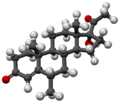Medroxyprogesterone
Medroxyprogesterone is a type of progestin, a class of hormone that mimics the effects of naturally occurring progesterone. It is used in a variety of medical applications, including as a component of hormone replacement therapy, in the treatment of abnormal uterine bleeding, and as a method of birth control.
Medical Uses[edit]
Medroxyprogesterone is used in the treatment of a variety of medical conditions. It is often prescribed as part of hormone replacement therapy for menopausal women, to help alleviate symptoms such as hot flashes and vaginal dryness. It is also used to treat abnormal uterine bleeding, by helping to regulate the menstrual cycle.
In addition, medroxyprogesterone is used as a method of birth control. It is the active ingredient in the Depo-Provera injection, which provides protection against pregnancy for three months at a time.
Side Effects[edit]
Like all medications, medroxyprogesterone can cause side effects. These may include nausea, bloating, breast tenderness, and changes in menstrual bleeding patterns. In rare cases, it can cause more serious side effects such as blood clots, stroke, or heart attack.
Pharmacology[edit]
Medroxyprogesterone works by mimicking the effects of naturally occurring progesterone. It binds to progesterone receptors in the body, which helps to regulate the menstrual cycle and prevent ovulation.
History[edit]
Medroxyprogesterone was first synthesized in the 1950s, and has been used in medical practice since the 1960s. It is now one of the most commonly prescribed progestins in the world.
See Also[edit]
This article is a Birth control-related stub. You can help WikiMD by expanding it!
-
Medroxyprogesterone
-
Medroxyprogesterone
Ad. Transform your life with W8MD's Budget GLP-1 injections from $75


W8MD offers a medical weight loss program to lose weight in Philadelphia. Our physician-supervised medical weight loss provides:
- Weight loss injections in NYC (generic and brand names):
- Zepbound / Mounjaro, Wegovy / Ozempic, Saxenda
- Most insurances accepted or discounted self-pay rates. We will obtain insurance prior authorizations if needed.
- Generic GLP1 weight loss injections from $75 for the starting dose.
- Also offer prescription weight loss medications including Phentermine, Qsymia, Diethylpropion, Contrave etc.
NYC weight loss doctor appointmentsNYC weight loss doctor appointments
Start your NYC weight loss journey today at our NYC medical weight loss and Philadelphia medical weight loss clinics.
- Call 718-946-5500 to lose weight in NYC or for medical weight loss in Philadelphia 215-676-2334.
- Tags:NYC medical weight loss, Philadelphia lose weight Zepbound NYC, Budget GLP1 weight loss injections, Wegovy Philadelphia, Wegovy NYC, Philadelphia medical weight loss, Brookly weight loss and Wegovy NYC
|
WikiMD's Wellness Encyclopedia |
| Let Food Be Thy Medicine Medicine Thy Food - Hippocrates |
Medical Disclaimer: WikiMD is not a substitute for professional medical advice. The information on WikiMD is provided as an information resource only, may be incorrect, outdated or misleading, and is not to be used or relied on for any diagnostic or treatment purposes. Please consult your health care provider before making any healthcare decisions or for guidance about a specific medical condition. WikiMD expressly disclaims responsibility, and shall have no liability, for any damages, loss, injury, or liability whatsoever suffered as a result of your reliance on the information contained in this site. By visiting this site you agree to the foregoing terms and conditions, which may from time to time be changed or supplemented by WikiMD. If you do not agree to the foregoing terms and conditions, you should not enter or use this site. See full disclaimer.
Credits:Most images are courtesy of Wikimedia commons, and templates, categories Wikipedia, licensed under CC BY SA or similar.
Translate this page: - East Asian
中文,
日本,
한국어,
South Asian
हिन्दी,
தமிழ்,
తెలుగు,
Urdu,
ಕನ್ನಡ,
Southeast Asian
Indonesian,
Vietnamese,
Thai,
မြန်မာဘာသာ,
বাংলা
European
español,
Deutsch,
français,
Greek,
português do Brasil,
polski,
română,
русский,
Nederlands,
norsk,
svenska,
suomi,
Italian
Middle Eastern & African
عربى,
Turkish,
Persian,
Hebrew,
Afrikaans,
isiZulu,
Kiswahili,
Other
Bulgarian,
Hungarian,
Czech,
Swedish,
മലയാളം,
मराठी,
ਪੰਜਾਬੀ,
ગુજરાતી,
Portuguese,
Ukrainian



